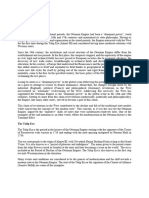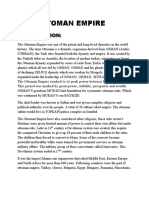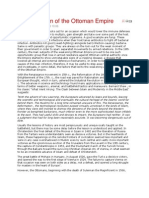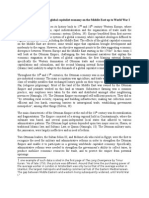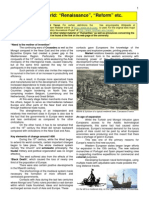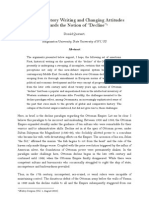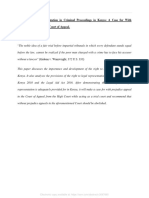0 ratings0% found this document useful (0 votes)
9 viewsTurkey Modern History.
Turkey Modern History.
Uploaded by
fatimaghalaezzahraeThe document provides a detailed summary of Turkey's modern history from 1800 to the late 19th century. It describes the Ottoman Empire's declining military and increasing fiscal crisis in the 18th century. The 19th century brought reforms under sultans like Selim III and Mahmut II to modernize the army and bureaucracy, establish new institutions, and bring the religious foundations under government control. However, reform efforts faced opposition and were undermined by their reliance on local elites. The period of the Tanzimat saw further modernizing reforms but also economic difficulties for the Ottoman Empire in integrating with the capitalist system and defaulting on debts in the 1870s.
Copyright:
© All Rights Reserved
Available Formats
Download as DOCX, PDF, TXT or read online from Scribd
Turkey Modern History.
Turkey Modern History.
Uploaded by
fatimaghalaezzahrae0 ratings0% found this document useful (0 votes)
9 views3 pagesThe document provides a detailed summary of Turkey's modern history from 1800 to the late 19th century. It describes the Ottoman Empire's declining military and increasing fiscal crisis in the 18th century. The 19th century brought reforms under sultans like Selim III and Mahmut II to modernize the army and bureaucracy, establish new institutions, and bring the religious foundations under government control. However, reform efforts faced opposition and were undermined by their reliance on local elites. The period of the Tanzimat saw further modernizing reforms but also economic difficulties for the Ottoman Empire in integrating with the capitalist system and defaulting on debts in the 1870s.
Original Title
turkey modern history.
Copyright
© © All Rights Reserved
Available Formats
DOCX, PDF, TXT or read online from Scribd
Share this document
Did you find this document useful?
Is this content inappropriate?
The document provides a detailed summary of Turkey's modern history from 1800 to the late 19th century. It describes the Ottoman Empire's declining military and increasing fiscal crisis in the 18th century. The 19th century brought reforms under sultans like Selim III and Mahmut II to modernize the army and bureaucracy, establish new institutions, and bring the religious foundations under government control. However, reform efforts faced opposition and were undermined by their reliance on local elites. The period of the Tanzimat saw further modernizing reforms but also economic difficulties for the Ottoman Empire in integrating with the capitalist system and defaulting on debts in the 1870s.
Copyright:
© All Rights Reserved
Available Formats
Download as DOCX, PDF, TXT or read online from Scribd
Download as docx, pdf, or txt
0 ratings0% found this document useful (0 votes)
9 views3 pagesTurkey Modern History.
Turkey Modern History.
Uploaded by
fatimaghalaezzahraeThe document provides a detailed summary of Turkey's modern history from 1800 to the late 19th century. It describes the Ottoman Empire's declining military and increasing fiscal crisis in the 18th century. The 19th century brought reforms under sultans like Selim III and Mahmut II to modernize the army and bureaucracy, establish new institutions, and bring the religious foundations under government control. However, reform efforts faced opposition and were undermined by their reliance on local elites. The period of the Tanzimat saw further modernizing reforms but also economic difficulties for the Ottoman Empire in integrating with the capitalist system and defaulting on debts in the 1870s.
Copyright:
© All Rights Reserved
Available Formats
Download as DOCX, PDF, TXT or read online from Scribd
Download as docx, pdf, or txt
You are on page 1of 3
SUMMARY OF:
TURKEY A MODERN HISTORY
A summary made by: Iliass Derouich
The title implies that there is such a thing as modern history (or even modern Turkey) and
hence is the result of periodization. The author discusses this aspect of the book with the
reader, rather than suggesting that it is in some way the unavoidable work of history itself.
The European economy is based on the work of scholars who support and apply
Wallerstein's dependency theory to explain how Turkey came to occupy a subservient place
on the periphery of a capitalist world system. Historians who are informed by the concept of
modernization see developments in the Ottoman Empire and Turkey as a struggle between
traditionalists and reactionaries.
In 1800 the governmental system could still be characterized as patrimonial: it formed an
extension of the sultan's household. According to the Ottoman ideology, society in the empire
was organized around a – theoretically strict – distinction between a ruling elite, which did not
pay taxes and was entitled to carry arms. The Ottoman elite exercised power through an
extended household, a 'great tradition', based on written Islamic sources and a secular code
of conduct. There was an exceedingly wide chasm between this civilization and the almost
illiterate rural population. One link between the elite civilization and popular culture was
formed by the mystical orders or fraternities.
The military weakness of the Ottoman Empire led to a permanent fiscal crisis. War, once an
important source of income for the empire, had become a loss-making industry. In the
provinces, both Asiatic and Europe, the eighteenth century had witnessed the rise of the
ayan. Selim III's government was ineffective when it came to financing reforms. He had
alienated the military by his efforts to create a new army and the majority of the ulema
disliked French influence. The first ambassadors were by all accounts less than effective in
representing the Ottoman people to Europe.
The Philiki Hetairia, a Greek patriotic society founded in Odessa in 1814, had been busy
founding cells throughout the Balkans. The rebels were badly organized and divided among
themselves. But the Ottoman army in 1821–24 signally failed to defeat them. The Russians
received the diplomatic prize they had aimed for in the treaty of Hünkar İskelesi, concluded
in. The policies of Sultan Mahmut II from 1826 onwards determined the direction that
Ottoman reform efforts would take. They were ultimately aimed at strengthening the central
state through building a modern army.
Launched the first Ottoman newspaper, the Moniteur Ottoman with its Ottoman-language
equivalent, the Takvim-i Vekai, in 1831. He brought the holdings of the religious foundations
under government control. Institutions resembling a treasury department and a justice
ministry also evolved.
The sultan sent a small group of students to Europe in 1827 for the first time. Europe and of
a European language led to new types of education. Problems hampered efforts to reform
during Mahmut's reign and those of his successors undermined by five main factors. Mahmut
II's reforms had to be executed through the people, such as the provincial notables, whose
abuses the reforms were intended to terminate. The economic developments of Mahmut II
and his immediate successors must be understood in the context of worldwide economic
trends. Great Britain had emerged from the Napoleonic wars without real rivals as a global
trading nation.
Mahmut's death did not mark the beginning of a period of reaction, as Selim III's death had in
1807. In June 1841 Mehmet Ali accepted the loss of his Syrian provinces in exchange for the
hereditary governorship of Egypt. The most violent inter-communal conflict of these years
was fought out in Lebanon. Britain declared war in March 1854 after mediation by France,
Britain, Austria, Prussia and Prussia failed. A peace conference was held in Paris in
February–March 1856 and produced the Treaty of Paris. Although the war had been fought
to defend the Ottoman Empire it had to accept peace terms.
The Victorian age saw a marked increase in piety and the activity of missionary societies.
The army, now called the nizamiye troops, was expanded and given modern European
equipment. Efforts to establish a fairer and more effective system of taxation were also
made. In 1840 a reorganization of the system of taxation was announced. In 1864 a new law
on provincial organization introduced a complete hierarchical system of provinces. The
canon law of Islam, the şeriat, was never abrogated, but its scope was limited almost
completely to family law.
The period of the Tanzimat coincided with the mid-century economic boom in Europe.
Ottoman economy into the capitalist system progressed faster than before. Priority was given
to the creation of professional training colleges for the bureaucracy and army. Secularization
was also the most important trend in education during this period. Many of the reform policies
of the Ottoman Empire in the 18th and 19th centuries were implemented by lesser
bureaucrats. But many of the lesser bureaucrats had only a superficial knowledge of the
West, combined with a snobbish rejection of traditional Ottoman ways. The first Ottoman
newspaper was started in Sultan Mahmut's days but was more an official bulletin than a
newspaper in the modern sense.
After the death of Fuat Pasha and Ali Pasha, Ottoman reformers were in temporary eclipse.
The crash on stock exchanges in 1873 marked the beginning of the Great Depression in the
European economy. Ottoman Empire could no longer pay interest on older loans and had to
default on its debt. In spite of their inexperience and the lack of representative traditions in
the empire, many members genuinely tried to represent the views of their constituencies
responsibly. The parliament almost totally failed in its legislative functions, partly because the
constitution allowed the sultan and his ministers to govern by decree, but it was an effective
forum for criticism of the government’s conduct of affairs – so effective and irritating, in
fact, that on 14 February 1878, the sultan prorogued it indefinitely. This, to all intents and
purposes, meant the end of the constitutional regime and, from this time on, Sultan
Abdülhamit II not only reigned but also ruled as an absolute monarch for 30 years.
Railway construction, requiring as it does much greater investment, was far slower to
develop, but still, the mileage was greatly extended in these years. French and British
companies had built the first railways in the Ottoman Empire. Macedonia was connected to
the capital, as was the interior of Anatolia with the building of the Anatolian railway, which
reached Ankara in 1892 and Konya four years later. ‘Baghdad railway’, which caused a great
deal of tension between the great powers in the years before the First World War.
In combination with the railway lines connecting the ports to the productive hinterland, the
steamships speeded up the integration into the capitalist system of some areas and some
sectors of the Ottoman economy. Improved education led to increased literacy, creating a
market for the Ottoman press, which expanded rapidly under Abdülhamit in terms of both the
number of publications and circulation figures.
You might also like
- The Decline of The Ottoman EmpireDocument6 pagesThe Decline of The Ottoman EmpireEmilypunkNo ratings yet
- Barangay Disaster Risk Reduction Management Committee (BDRRMC)Document5 pagesBarangay Disaster Risk Reduction Management Committee (BDRRMC)sadz100% (3)
- Cabinet Battle #1 Close ReadDocument5 pagesCabinet Battle #1 Close ReadMichael Milton78% (18)
- The Earth and It's Peoples Ch. 25 OutlineDocument4 pagesThe Earth and It's Peoples Ch. 25 OutlineLizziebee280% (10)
- Decline and Modernization of The Ottoman EmpireDocument20 pagesDecline and Modernization of The Ottoman EmpireThomas JenningsNo ratings yet
- Major Essay AssignmentDocument6 pagesMajor Essay AssignmentIqbal bin YusufNo ratings yet
- Turkey A Modern History Erik J ZurcherDocument12 pagesTurkey A Modern History Erik J ZurcherAnthony Ccahuana OsccorimaNo ratings yet
- Lesson 3Document5 pagesLesson 3rana.mo200117No ratings yet
- Gunpowder EmpiresDocument20 pagesGunpowder EmpiresBrian Roberts100% (1)
- 24 Land Empires in The Age of ImperialsimDocument8 pages24 Land Empires in The Age of ImperialsimJonathan Daniel KeckNo ratings yet
- Mindterms Main Points SummaryDocument7 pagesMindterms Main Points SummaryaboodabogusNo ratings yet
- The Empire From 1807 To 1920Document12 pagesThe Empire From 1807 To 1920LaloNo ratings yet
- Ottoman LiberalismDocument79 pagesOttoman LiberalismAmirRJamaludin100% (1)
- Gale Researcher Guide for: Tanzimat Reforms and Modernization in the Ottoman EmpireFrom EverandGale Researcher Guide for: Tanzimat Reforms and Modernization in the Ottoman EmpireNo ratings yet
- Reasons For Collapse of Ottoman EmpireDocument8 pagesReasons For Collapse of Ottoman EmpireBilal Ahmed Khan100% (2)
- The Evolution of Fiscal Institutions in The Ottoman Empire, 1500-1914Document40 pagesThe Evolution of Fiscal Institutions in The Ottoman Empire, 1500-1914Ahmed SecunovicNo ratings yet
- Week 2 His101 History of Turkish Revolution and Ataturk's Principles IDocument6 pagesWeek 2 His101 History of Turkish Revolution and Ataturk's Principles Iozcan8479No ratings yet
- Reflection PaperDocument6 pagesReflection PaperCherif ChokeirNo ratings yet
- Ali Uzay Peker - Western Influences On The Ottoman Empire and Occidentalism in The Architecture of IstanbulDocument26 pagesAli Uzay Peker - Western Influences On The Ottoman Empire and Occidentalism in The Architecture of IstanbulpetrospetrouNo ratings yet
- Week 3 History of Turkish Revolution and Ataturk's Principles IDocument6 pagesWeek 3 History of Turkish Revolution and Ataturk's Principles Iozcan8479No ratings yet
- The Price Revolution of The Sixteenth Century - BarkanDocument27 pagesThe Price Revolution of The Sixteenth Century - BarkanhalobinNo ratings yet
- Ottoman EmpireDocument2 pagesOttoman Empirekizmitul41No ratings yet
- Change and Continuity - Ottoman EmpireDocument3 pagesChange and Continuity - Ottoman Empireapi-319328739No ratings yet
- CHAPTER 24 OUTLINE Land Empires in The Age of ImperialismDocument5 pagesCHAPTER 24 OUTLINE Land Empires in The Age of ImperialismAdam Yu100% (4)
- The Ottoman EmpireDocument9 pagesThe Ottoman EmpireAyla ImranNo ratings yet
- Ottoman Empire Essay ThesisDocument4 pagesOttoman Empire Essay Thesisirywesief100% (2)
- THE PLACE OF THE YOUNG TURK REVOLUTION IN TURKISH HISTORY (1) After Mid 1Document4 pagesTHE PLACE OF THE YOUNG TURK REVOLUTION IN TURKISH HISTORY (1) After Mid 1AwuduNo ratings yet
- The Place of The Young Turk Revolution IN Turkish HistoryDocument17 pagesThe Place of The Young Turk Revolution IN Turkish Historycalibann100% (2)
- The Factors Responsible For Transition From Feudalism To CapitalismDocument10 pagesThe Factors Responsible For Transition From Feudalism To CapitalismAmanda MachadoNo ratings yet
- History of The Ottoman Empire and Modern TurkeyDocument543 pagesHistory of The Ottoman Empire and Modern TurkeyAhmet Er100% (5)
- HIstory of The Ottoman Empire and Modern Turkey Vol. 2 (Stanford Shaw)Document298 pagesHIstory of The Ottoman Empire and Modern Turkey Vol. 2 (Stanford Shaw)afwefasdfwefasdf100% (2)
- Ottoman Empire and Modern Turkey 1808-1974 History - ofDocument543 pagesOttoman Empire and Modern Turkey 1808-1974 History - ofGeorge Saliba100% (1)
- Land Empires in The Age of ImperialismDocument6 pagesLand Empires in The Age of Imperialism張淩淩No ratings yet
- Ottoman Historiography and The SeventeenDocument25 pagesOttoman Historiography and The SeventeenEmri MbiemriNo ratings yet
- The Modernization of Ottoman DiplomacyDocument13 pagesThe Modernization of Ottoman DiplomacyLeonardo GarzonNo ratings yet
- Easternquestion Wikipedia 1711174357591Document43 pagesEasternquestion Wikipedia 1711174357591justdani731No ratings yet
- History of TurkeyDocument3 pagesHistory of TurkeyMohammad ChawreNo ratings yet
- Analyze The Reforms of Sultan Selim III. International Ataturk Alatoo UniversityDocument2 pagesAnalyze The Reforms of Sultan Selim III. International Ataturk Alatoo UniversityAydana Sheralieva0% (1)
- Alexandre, Giulio and Francisco-MagazineDocument21 pagesAlexandre, Giulio and Francisco-Magazinegoat54841No ratings yet
- Secularim and IslamDocument18 pagesSecularim and IslamSalim UllahNo ratings yet
- Material de Clase DemostrativaDocument5 pagesMaterial de Clase DemostrativaLuis Armando LeónNo ratings yet
- Disintegration of The Ottoman EmpireDocument9 pagesDisintegration of The Ottoman EmpireNoman SarwarNo ratings yet
- History of The Modern Middle East MidtermDocument4 pagesHistory of The Modern Middle East MidtermNadine FattalehNo ratings yet
- Dissolution of The Ottoman EmpireDocument19 pagesDissolution of The Ottoman Empireawaab naveedNo ratings yet
- Facts About Ottoman EmpireDocument3 pagesFacts About Ottoman EmpireAlisa Syakila MaharaniNo ratings yet
- The Islamic Empire That Dominated Much of The Mediterranean Region From The Fourteenth To The Twentieth CenturiesDocument42 pagesThe Islamic Empire That Dominated Much of The Mediterranean Region From The Fourteenth To The Twentieth CenturiesSyed Hasnain AbbasNo ratings yet
- Ottoman ReadingDocument4 pagesOttoman ReadingrajaNo ratings yet
- Barkan PriceRevolutionSixteenth 1975Document27 pagesBarkan PriceRevolutionSixteenth 1975Ufuk özesmerNo ratings yet
- Assignment Ottoman EmpireDocument4 pagesAssignment Ottoman EmpireRobert BrookeNo ratings yet
- Summaries 1Document4 pagesSummaries 1viktoriastoilova6No ratings yet
- Different Opinions On Ottoman and German Political Military and Economic RelationsDocument22 pagesDifferent Opinions On Ottoman and German Political Military and Economic RelationsTÜRK KAFASINo ratings yet
- Modern Muslim World: BAHU3073 Session 3Document14 pagesModern Muslim World: BAHU3073 Session 3arslan shahNo ratings yet
- The Changing World: "Renaissance", "Reform" Etc.: "Need Is The Mother of Invention"Document7 pagesThe Changing World: "Renaissance", "Reform" Etc.: "Need Is The Mother of Invention"Tuğçe DağtekinNo ratings yet
- The Age of Reforms. The Tanzimat PeriodDocument25 pagesThe Age of Reforms. The Tanzimat PeriodAnonymous Fwe1mgZNo ratings yet
- Yelda Demirag From Ottomanism To TurkismDocument20 pagesYelda Demirag From Ottomanism To TurkismrodmariamNo ratings yet
- ClothingDocument23 pagesClothingOğuzhan ÖzdemirNo ratings yet
- AnthropologyDocument8 pagesAnthropology4pnw8ycddgNo ratings yet
- OttomanDocument3 pagesOttomanhaticesila204No ratings yet
- A History of Modern Europe from the Capture of Constantinople by the Turks to the Treaty of Berlin , 1878From EverandA History of Modern Europe from the Capture of Constantinople by the Turks to the Treaty of Berlin , 1878No ratings yet
- Quataert DeclineDocument10 pagesQuataert DeclineAbhinava GoswamiNo ratings yet
- 1 Van de Brug v. Philippine National BankDocument18 pages1 Van de Brug v. Philippine National BankHannah Keziah MoralesNo ratings yet
- 35 Days Spectrum Modern History PlanDocument6 pages35 Days Spectrum Modern History Planshravan kumar ankemNo ratings yet
- Govt of India Act 1919 and 1935Document6 pagesGovt of India Act 1919 and 1935Anonymous100% (1)
- Marvin Harris Theories of Culture in Postmodern Times 1999Document113 pagesMarvin Harris Theories of Culture in Postmodern Times 1999Omar MumallahNo ratings yet
- PTR 38Document23 pagesPTR 38CyNo ratings yet
- State Autonomy Movement in Jharkhand State Politics in IndiaDocument6 pagesState Autonomy Movement in Jharkhand State Politics in Indiaishujaglan03No ratings yet
- Adibc 1Document3 pagesAdibc 1Sheril ChandraboseNo ratings yet
- Vat Act 2013Document84 pagesVat Act 2013Linda M KariukiNo ratings yet
- Builders Directory All Over Mumbai Thane and Navi Mumbai PDF FreeDocument26 pagesBuilders Directory All Over Mumbai Thane and Navi Mumbai PDF FreeCedric KerkettaNo ratings yet
- D-23-290 ItbdDocument34 pagesD-23-290 ItbdyokebtcNo ratings yet
- Right To Legal Representation in Criminal Proceedings in KenyaDocument26 pagesRight To Legal Representation in Criminal Proceedings in KenyabwalawfirmNo ratings yet
- Carbonell v. Metrobank G.R. No. 178467 April 26, 2017 Case DigestDocument3 pagesCarbonell v. Metrobank G.R. No. 178467 April 26, 2017 Case DigestyourlazyunnieNo ratings yet
- Innocuousism Elective ShiereyDocument3 pagesInnocuousism Elective ShiereyMaria CeciliaNo ratings yet
- The Fall of Tokugawa Shogunate PDFDocument14 pagesThe Fall of Tokugawa Shogunate PDFRobin RalhanNo ratings yet
- Power Point Advanced Financial AccountingDocument12 pagesPower Point Advanced Financial AccountingAnfal KankouniNo ratings yet
- Quiz Quiz TradeDocument7 pagesQuiz Quiz TradeEricHoldenNo ratings yet
- Pengaruh Manajemen Laba Terhadap Keputusan Investasi Dengan Kompensasi Berbasis Ekuitas Sebagai Variabel PemoderasiDocument15 pagesPengaruh Manajemen Laba Terhadap Keputusan Investasi Dengan Kompensasi Berbasis Ekuitas Sebagai Variabel PemoderasiIdris SiddiqNo ratings yet
- Quiz - Partnership CompanyDocument4 pagesQuiz - Partnership Companyzinsike444No ratings yet
- AML Risk AssessmentDocument16 pagesAML Risk AssessmentOeun Penh100% (1)
- Test Ta 1107Document3 pagesTest Ta 1107Thanh Thảo TrươngNo ratings yet
- Ifrs 13Document11 pagesIfrs 13mulualem100% (4)
- Industrial Relations: Unit 7Document24 pagesIndustrial Relations: Unit 7Rahul Pinnamaneni100% (10)
- Chavez v. Public Estates Authority - Macavinta PDFDocument2 pagesChavez v. Public Estates Authority - Macavinta PDFMai BinondoNo ratings yet
- Brief - Markandey Katju V Lok SabhaDocument5 pagesBrief - Markandey Katju V Lok SabhaAditi BanerjeeNo ratings yet
- D.M. Harish Memorial Government Law Coll PDFDocument45 pagesD.M. Harish Memorial Government Law Coll PDFKhushi AgarwalNo ratings yet
- Essentials Quality Control Plan SampleDocument11 pagesEssentials Quality Control Plan SampleSakhawat HossainNo ratings yet
- Math 101 Final Formula SheetDocument4 pagesMath 101 Final Formula SheetOmnia KhattabNo ratings yet
- Non SalaryDocument1 pageNon SalaryRajNo ratings yet







